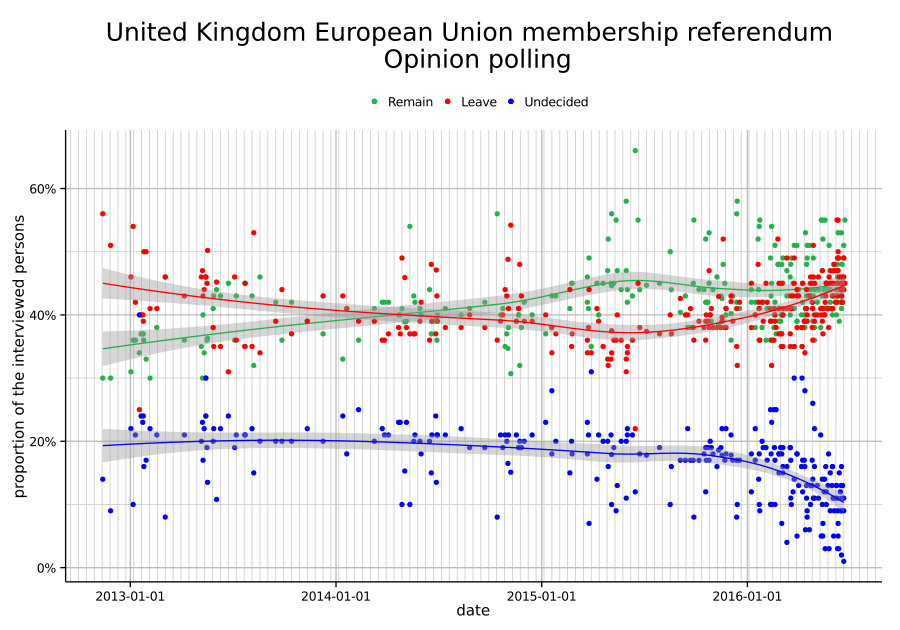
Wikipedia provides an excellent summary graphic (above) of opinion polling in the 2017 French Presidential election (first round). It is illegal to publish any more opinion polls after midnight last night, so this is the final picture we have of the state of the race prior to the election. Of course with any polling, one has to issue a number of caveats:
Firstly, the opinion polls called both the Brexit and Trump elections wrong. Yes Hillary Clinton did win the popular vote by c. 3%, but polls had her winning by a higher margin, and predictions were based on state level polling and these called the crucial swing states of Pennsylvania, Wisconsin, Michigan and Florida wrong. Given these predictions were based on hundreds of polls, this was an industry level failure.
Similarly, Brexit polls overwhelmingly showed the Remain side to have a narrow lead although some polls did show a majority for leave, and the trend line showed a significant convergence in the last few weeks and days of the campaign:

In both cases pollsters faced the problem of how to predict the behaviour of late breaking undecided voters in the race who appear to have plumped heavily for Brexit and Trump. There may also have been a shy Tory effect, whereby respondents may have been reluctant to share their real preferences with pollsters, for fear of being seen to make an unfashionable or unpopular choice.
Pollsters in the French Presidential elections may have similar difficulties, with even recent polls showing a level of undecided or abstention in the 20-30% range. How these potential voters behave will be crucial to the eventual outcome, given that the four leading contenders are all within a narrow 5% range.
There may also be large scale tactical voting with voters voting not necessarily for their preferred candidate, but for a candidate they perceive to be at least minimally acceptable, in order to ensure they will have at least one acceptable candidate to vote for in the second round.
This could damage candidates such as Hamon who are seen as being unlikely to make the second round, with Parti Socialiste voters opting for Mélenchon or Macron instead. Similarly some Fillon supporters may opt for Macron if they feel the latter has a better chance of making the second round and if they do not wish to be faced with a choice of Le Pen or Mélenchon at that stage.
Finally, there is the impact of late breaking events such as the terrorist incident in the Champs Elysees last Thursday. Will this help more right wing “Law and Order” or racist candidates like Le Pen or Fillon? Only three opinion pollsters were in the field on Friday, and appear to have found no discernable impact on voter intentions. But in fairness to pollsters, it is very difficult to discern how this might impact the outcome on Sunday.
But if we were to take the polling trends at face value, what outcome can we expect? The graphical trendline of polls (see top image) appears to show Macron establishing a small lead over Le Pen at the top of the leader board, with Fillon maintaining an even smaller lead over a surging Mélenchon who appears to be benefiting from Hamon’s rapid decline and elimination as a likely second round contender.
Le Pen has been declining steadily in the polls perhaps because Mélenchon is also eating into her anti-EU support whilst also becoming a credible second round candidate. Despite some last minute jitters in the Macron camp, Macron appears to be holding his overall lead in the contest.
So the most likely second round scenario would therefore appear to indicate a Macron/Le Pen contest, with Macron winning easily by a 62-37% margin. Macron would also beat Fillon by a 65-35% margin or Mélenchon by a 60-40% margin. Mélenchon would also beat Le Pen by c. 60-40% or Fillon by 56-44%, and Fillon would beat Le Pen by c. 57-43%.
It thus appears that the French people would prefer almost anyone to Le Pen in the second round, with Macron slightly favoured to be her opponent and ultimate victor in the second round. However Macron’s support is also viewed as being the “softest”, with many people unclear as to his policies and viewing him as, at best, the lesser of four evils. He doesn’t have a long established party machine to support his candidacy and is therefore most at risk of under-performing his polls.
With 20-30% of voters still undecided or likely to abstain, any combination of the leading four candidates is still possible. We are thus likely to see a President Macron, Fillon, Mélenchon, or Le Pen in declining order of probability.




